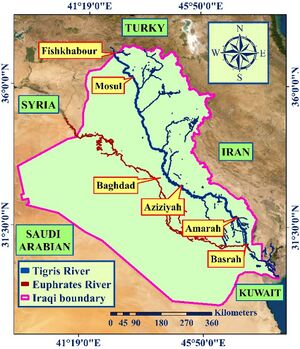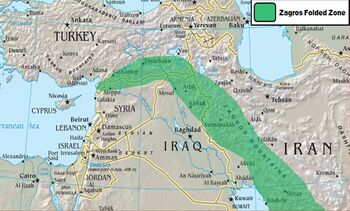Bagdad
| Author:Laxman Burdak, IFS (Retd.) |


Bagdad or Baghdad (Hindi: बग़दाद , Arabic: بغداد Baġdād) is the capital of Iraq.
Location
Located along the Tigris River, the city was founded in the 8th century and became the capital of the Abbasid Caliphate.
Origin
The site where the city of Baghdad came to stand has been populated for millenia and by the 8th century AD several Aramaic Christian villages had developed there, one of which was called Baghdad, the name which would come to be used for the Abbasid metropolis.[1]
The name has been used as Baghdadu on Assyrian cuneiform and Babylonian records going back to at least 2000 BC.[2][3] An inscription by Nebuchadnezzar (600 BC) describes how he rebuilt the old Babylonian town of Bagh-dadu.[4] There used to be another Babylonian settlement called Baghdad, in upper Mesopotamia, near the ancient city of Edessa. The name has not been attested outside of Mesopotamia.[5]
Even though the name has been attested in pre-Persian times, a Persian origin has been accepted by some scholars. It has been proposed that the name is a Middle Persian compound of Bag "god" and dād "given", translating to "God-given" or "God's gift", from which comes Modern Persian Baɣdād. This in turn can be traced to Old Persian.[6] Another proposal is the Persian compound bāğ "garden" and dād "fair", translating to "The fair garden". A Persian explanation is problematic though, given that the name was used long before the Persians arrived in Mesopotamia.[1]
When the Abbasid caliph, al-Mansur, founded a completely new city for his capital, he chose the name Madinat al-Salaam or City of Peace. This was the official name on coins, weights, and other official usage, although the common people continued to use the old name. By the 11th century, "Baghdad" became almost the exclusive name for the world-renowned metropolis.
Jats dislodged the Abbasid Caliphate seat of power at Baghdad

When 23,000 Jats dislodged the Abbasid Caliphate seat of power at Baghdad in 9th century AD.(Please Read)
(Sources-Majma Al Bahrain,A History of Persia by Percy Sykes,A Short History of Islam Page 640, Shindological Studies Volume 4-7-Pages 38 to 42, Chronoly Encyclopedia of World History by W.L Langers Page 189 and many more)
The Abbasid Caliphate was the strongest and richest kingdom on the world at that time. They were ruling territory from Central Asia to North Africa.This time is also known as the golden period of Islam. According to the Book A History of Persia, "Under the orders of Walid I, at the beginning of the eighth century A.D., a large number of Jatts had been taken as soldiers by Arabs and transported from the lower Indus (river) to the marches of the Tigris (river in modern Iraq). The Jats soldier took all there belonging their families and even there cattles to Mesopotamia (They are credited with introducing water buffalo to this region and Europe). Soon after establishing in the new land, they started revolt against the Caliphate. They closed the Basra-Baghdad road which led to very high food prices in the capital, as the result successive Caliphs (The Caliph al-Ma'mun in his lifestyle was not able to suppress the Jats) lifetimesent their armies to subdue them. The famous Persian poet, Tabari, expressed their insolence in the following poem:
- O people of Baghdad die!
- May your dismay last for forever!
- We Jats have defeated you, by forcing you to battle with us in the open country.
- We Jats have driven you in front of us like a flock of weaklings.
At the beginning Arab generals were unsuccessful to subdue them and The Kalifa Al-Mu'tasim as soon as coming into power send a army against Jats and ultimately one Arab general (A.D. 834) was successful to cut Jat communications which resulted in their surrender. Jats were exiled because of their revolt to Khanikin on the Turkish frontier and to the frontiers of Syria". Though there capture of Baghdad didn't lasted long. They were able bring the greatest empire of it's time to toes being so less in number and so far from there homeland.
Background on Jats and Arab relationship
The Jats of Sindh were from very early time known for there skills at warfare and were employed in large amount in Sasanian Army of Persia. After the Rise of Islam military campaign were lunged against Sasanian Dynasty and Persia was conquered by Muslims this was the first time that Arabs came into contact with Jats. The Jat were one of oldest population of Sindh (at that time Sindh also included Baluchistan as the Baluch invasion didn't took place by then). Jats and Meds (These people are now nowhere to be found some people say there descendants are Mer,Meo and Meenas) divides the whole Sindh among themselves and use to fight among themselves. Jat were in possession of whole of Makran (Baluchistan) and other states to the west of Sindh. The most important Jat chief to the east of Indus was the Raja of Alor. Jats possessed great number of ships and well organised Navy. They started to raid Arabian ports. As per Arab records these raids by Al Zutts (Jatts) was the main reason for the Arab invasion of Al Hind (Sind). Arabs tried all possible ways, they sneaked into Kikkan pass by bypassing Hindu kings of Kabul and Zabulistan. But local Jats repulsed them with heavy losses.The 14 raids to Sindh through the desert of Makran failed, three of these raids were big but to no avail.Three Arab commanders namely Abdullah, Budail and Abdul Rahman perished in the process along with their army.
It was reported by survivors that:
“If small army is sent, it will be cut into pieces by Jats of Makran, if big army is sent it will be short of supplies of water and food in the desert.”
Basically Jats of Makran, Sindh, Kandhar and the passes of Hindu Kush did what great empires of Persia and Eastern Rome could not do. However western part of Makran bordering Zarang fell to Arabs. On the 15th expedition the Caliph sent Muhammed Bin Qasim to Sindh. Due to internal rifts and other political issues Arabs were able to capture Sindh. Soon Arabs were replaced by Indian Dynasties. Seeing the fighting skills of Jats the took them in there army in large numbers. From stopping Arabs 14 time to capturing Baghdad Jats of Sindh have achieved a lot in world history.
Source - Jat Kshatriya Culture
External links
References
- ↑ Encyclopedia of Islam
- ↑ Wadad Makdisi Cortas,p.55
- ↑ Palestine and Syria
- ↑ The Universal anthology
- ↑ Encyclopedia of Islam
- ↑ Guy Le Strange, "Baghdad During the Abbasid Caliphate from Contemporary Arabic and Persian", p. 10
Back to Jat Places in Foreign

